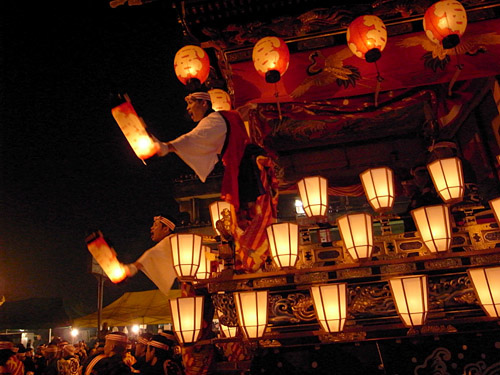Blog No.121
Author: Kyoko Akiyama
Hi everyone! I'm Kyoko Akiyama, the ELSI Origins Network (EON) project manager. It is hard to believe that 2015 is almost finished. I hope that your 2015 has been very exciting for you as it has been for me. The EON project which has a 33-month timeline in its initial phase was launched on July 1. Starting something new is often full of unexpected twists and turns. I enjoy working out these challenges but it has kept me and the EON team VERY busy these six months.
As a Japanese who loves the new year season, I had better find time to enjoy all the activities of this season. Since we have so many international researchers and visitors at ELSI, I would like to share some typical ways to welcome and celebrate New Years in Japan, our most important holiday season.
Although we have missed already this festival this year, I would like to mention it for your calendars next year. On 3/Dec every year, there is a Chichibu Night festival in Saitama prefecture that is worth going to.
http://navi.city.chichibu.lg.jp.e.qg.hp.transer.com/p_festival/1030/
On 13/Dec. all shrines and temples engage in big cleaning of their structures and grounds to get ready for the new year. This practice is called 煤払い(すすはらい) or "susu-harai". This is not just for practical cleaning but for a ritual and spiritual cleansing, to welcome the Gods for the new year. Maybe your near by shrines and temples are looking for volunteers (they usually need about 50 people to help them clean their huge estate). So, if interested, you can check to see if they are looking for volunteers to help them.
And cleaning is not only for shrines and temples. Japanese households all go through some home cleaning projects, much like the western idea of spring cleaning. The Japanese idea is to not carry over your dirt and clutter from the previous year into the pristine new year. If you go to your local stores, you will find all sorts of cleaning supplies for sale, interesting implements to get to those hard-to-reach places that you might ignore except for during the new years cleaning!
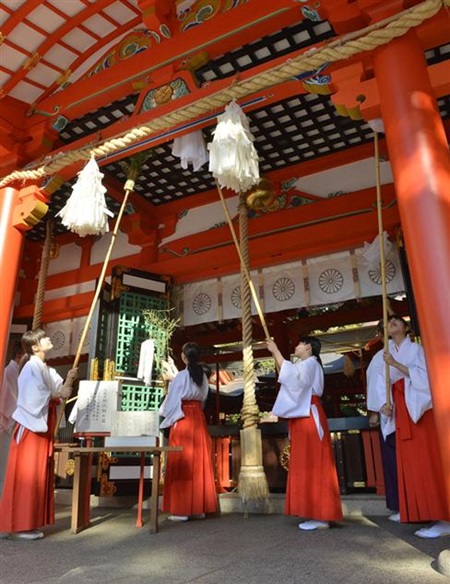
Between 13/Dec. - 28/Dec. is the season for putting up new years decorations. You should not be too early and you should not be too late. After the cleaning and before "last minute" decorations (avoid the 29th because the reading of "9" has the same sound as "suffer" and 31st because that leaves only one evening of decorations) households take care to put up various decorations such as kagami-mochi and kado-matsu (see below). Because the new years holiday is the most sacred for the Japanese, being on schedule is a deep form of respect. To be well prepared to receive the new year is a sign of sincere appreciation for the daily offerings and happenings in life.
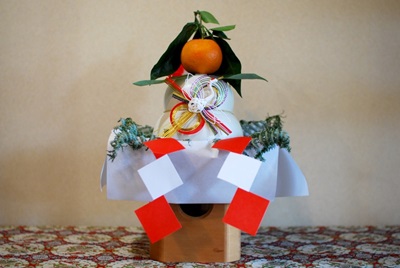
(Kagami-mochi)
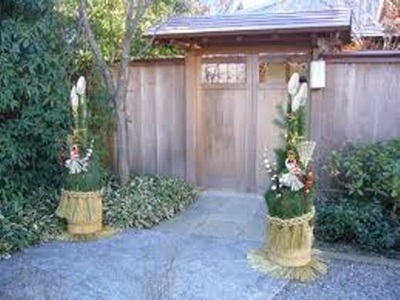
(Traditional kado-matsu that decorate the sides of the gate. Modern versions are single pine leaves on each side of the door)
In the old days of big and active families, being on schedule was the housewives' pride of managing their household well. The new years holiday was hard work. Now shops are open from 2/Jan or even on the actual new years day at some places but in the old days, shops were closed for a week to 10 days over the year end ~ new year holidays. So it was critical for housewives to not only be on schedule for cleaning but they had to shop for many vegetables and food items so as to be able to welcome their families and husbands' subordinates who would visit to pay their respects.
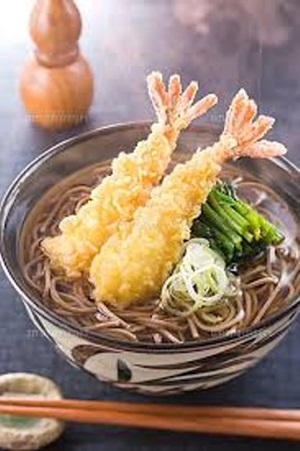
31/Dec. is the time to eat "toshi-koshi soba" (年越しそば / としこしそば). The tradition is to have soba and not udon noodles as the end of the year meal to wish for a prosperous new year and to have a long life (like soba, not like the lumpier, easy-to-break udon.)
In place of the New Years ball in Times Square, we have the joya-no-kane (除夜の鐘 / じょやのかね)where the temples ring their bells 108 times. There are several reasons why temples ring their bells 108 times, and we don't know which one is the correct answer but here is the most common explanation:
It is said that human beings suffer from 108 earthly desires. Each ring is supposed to remove (cleanse) each of those desires so that you can welcome the new year with pure and clean mind. 107 rings count down the end of the year and the final 108th ring welcomes in the new year.
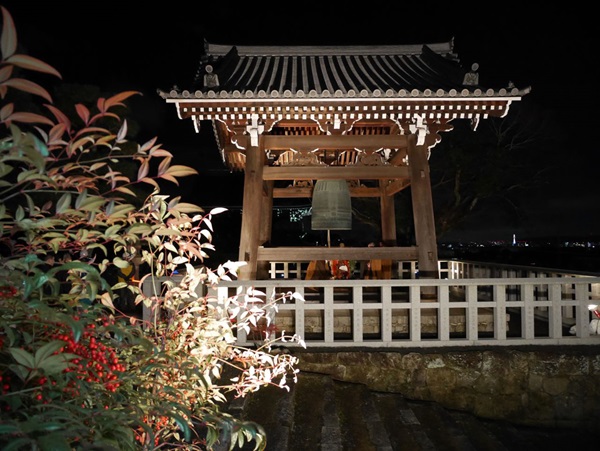
On 1/Jan., New Years Day, we wear new clothes, eat our "osechi ryori", a menu of auspicious foods which were once very decadent and once-a-year treats. We visit our relatives' houses (it is the younger generation that visits the older generation) to pay our respects and request their continued support for the coming year. We also visit our nearby shrines or temples to make our wishes for the new year (wish for dreams to come true, to pray for your family's safety and health, etc.)
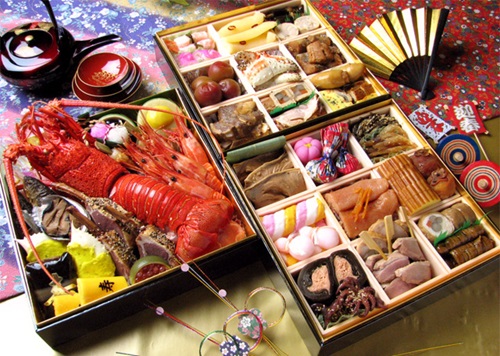
(Osechi ryori, traditional new years feast)
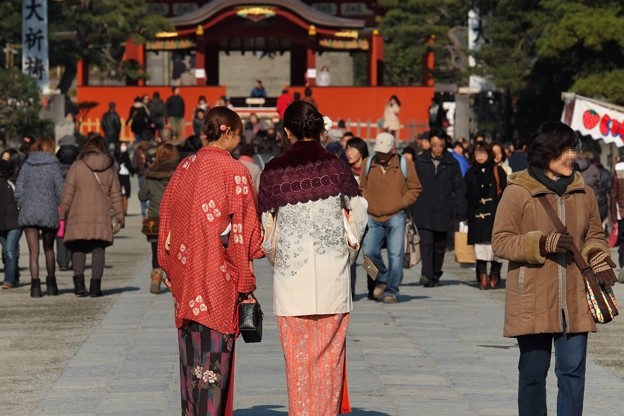
Usually, the new years holiday is spend with your family, much like the way Thanksgiving or Christmas is celebrated in the west.
On 7/Jan., slowly life begins to get back to normal. You can take down your new years decorations. (In the Kansai area - the western part of Japan, they tend to keep them up until a little before the 20th of January.) On this date, the tradition is to eat a 7-herb porridge to help your digestion system after eating too much "fabulous" foods over the holiday season. The 7 herbs that go into the porridge are:
1) Seri (Water dropwort)
2) Nazuna (Shepherd's Purse)
3) Gogyo (Cudweed)
4) Hakobera (chickweed)
5) Hotokenoza (Nipplewort)
6) Suzuna (Turnip)
7) Suzushiro (Radish)
You will see a set of these seven herbs sold in one package at your nearby supermarket on 7/Jan.
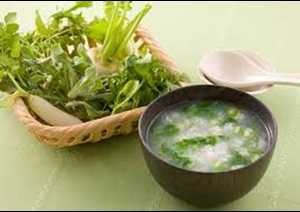
After 11/Jan, the kagami-mochi ornament is removed and the hardened mochi (glutinous rice cake) is cut up and eaten. The ritual of cutting up the kagami-mochi is called 'kagami-biraki' (鏡開き).
For our many international ELSI scientists and visitors who will be in Japan over the new years holiday, I hope you get to enjoy some of the activities mentioned above. And lastly, if you know any children or young teens, don't forget to prepare "otoshidama", a little envelope with some new years money!
Happy Holidays!
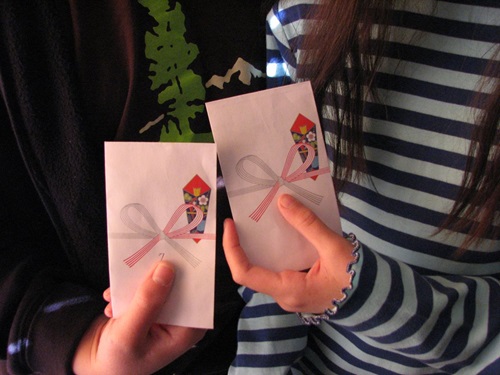
(Don't forget to prepare 'otoshidama' for the kids!)

